Haifanggou Formation
The formation consists of coarse conglomerates, sandstone, mudstone, and thin coal layers deposited in deltaic and lacustrine environments.
The formation dates to the Callovian of the Middle Jurassic to the Oxfordian of the Late Jurassic.
The most prominent locality of the Haifanggou Formation are the Daohugou Beds, located near the village of Daohugou in southeastern Inner Mongolia. Other localities include Wuhuaxigou, Chentaizi, Jiangzhangzi, Wubaiding, Guancaishan, Haifenggou, Fanzhangzi, and Zhuanshanzi.
Dating
Daohugou bed
The age of the Daohugou bed has been debated, and a number of studies, using different methodologies, have reached conflicting conclusions. Various papers have placed the fossils here as being anywhere from the Middle Jurassic period (169 million years ago) to the Early Cretaceous period (122 ma). One of the first studies on the age of the Daohugou beds, published in 2004 by He et al., found them to be Early Cretaceous, only a few million years older than the overlying Jehol beds of the Yixian Formation. The 2004 study primarily used Argon–argon dating of a tuff within the Daohugou Beds to determine its age.
However, subsequent studies cast doubt on this relatively recent age. In a 2006 study, Gao & Ren criticized He et al. for not including enough specifics and detail in their paper, and also took issue with their radiometric dating of the Daohugou tuff. The tuff, Gao and Ren argued, contains crystals with a variety of diverse radiometric ages, some up to a billion years old, so using dates from only a few of these crystals could not determine the overall age of the deposits. Gao and Ren went on to defend a Middle Jurassic age for the beds based on biostratigraphy (the use of index fossils), and the bed's relationship to a layer that is known to mark the Middle Jurassic-Late Jurassic boundary.
Another study, published in 2006 by Wang et al., argued that the 159-164 million years old Tiaojishan Formation underlies, rather than overlies, the Daohugou Beds. Unlike the earlier study by Gao and Ren, Wang et al. found an overall similarity between the fossil animals found in the Daohugou Beds and those from the Yixian Formation. The authors stated that
"vertebrate fossils such as Liaoxitriton, Jeholopterus and feathered maniraptorans show much resemblance to those of the Yixian Formation. In other words, despite the absence of Lycoptera, a typical fish of the Jehol Biota, the Daohugou vertebrate assemblage is closer to that of the Early Cretaceous Jehol Biota than to any other biota."
Wang et al. concluded that the Daohugou probably represents the earliest evolutionary stages of the Jehol Biota, and that it "belongs to the same cycle of volcanism and sedimentation as the Yixian Formation of the Jehol Group." However, a later study by Ji et al. argued that the key indicator of the Jehol biota are the index fossils Peipiaosteus and Lycoptera. Under this definition, the earliest evolutionary stage of the Jehol Biota is represented by the Huajiying Formation, and the Daohugou Formation is excluded due to the absence of Lycoptera fossils. Later in 2006, Liu et al. published their own study of the age of the Daohugou beds, this time using Zircon Uranium-lead dating on the volcanic rocks overlying and underlying salamander-bearing layers (salamanders are often used as index fossils). Liu et al. found that the beds formed between 164 and 158 million years ago, in the Middle to Late Jurassic. A 2012 study by Gao and Shubin agreed with this assessment, and reported an Argon–argon date of 164 plus or minus 4 million years ago for the Daohugou horizon.
Animal fossil content
Arthropods
At least 760 insect species have been described from the Haifanggou Formation and associated deposits, making it one of the most diverse insect-bearing strata from the Jurassic period.
| Insects | |||||
|---|---|---|---|---|---|
| Genus | Species | Year | Abundance | Notes | Images |
| Ahirmoneura | A. neimengguensis | 2008 | A tangle-veined fly |   | |
| Aneuroderma | A. oiodes | 2021 | 2 specimens | An earwig | |
| Applanatiforceps | A. angustus | 2023 | 3 specimens | An earwig | |
| Archaboilus | A. musicus | 2012 | 1 specimen | A stem-katydid | |
| Ekpagloderma | E. gracilentum | 2023 | 1 specimen | An earwig | |
| Formosibittacus | F. macularis | 2008 | 1 specimen | A hangingfly | |
| Fortiholcorpa | F. paradoxa | 2013 | 1 specimen | A Mecopteran | |
| Juracimbrophlebia | J. ginkgofolia | 2012 | 1 specimen | A hangingfly | |
| Jurahylobittacus | J. astictus | 2008 | 1 specimen | A hangingfly | |
| Mesobunus | M. dunlopi | 2012 | 1 specimen | A harvestman | |
| Miriholcorpa | M. forcipata | 2013 | 1 specimen | A Mecopteran | |
| Mongolarachne | M. jurassica | 2011 | A spider | ||
| Mongolbittacus | M. daohugoensis | 2007 | 1 specimen | A hangingfly | |
| Pseudomantina | P. baijuyii | 2023 | A cockroach | ||
| Pycnopolystoechotes | P. striatus | 2023 | A lacewing | ||
| Sinojuraphis | S. ningchengensis | 2008 | An aphid | ||
| Sinopalaeodermata | S. concavum | 2021 | 1 specimen | An earwig | |
| Stictopolystoechotes | S. sparsulus | 2023 | A lacewing | ||
Vertebrates
Based largely on.
| Genus | Species | Year | Notes | Images |
|---|---|---|---|---|
| Chunerpeton | C. tianyiensis | 2003 | A salamander | 
|
| Jeholotriton | J. paradoxus | A salamander | ||
| Neimengtriton | N. daohugouensis | A salamander | ||
| Pangerpeton | P. sinensis | A salamander | 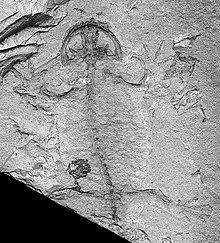 | |
| Jeholopterus | J. ningchengensis | An anurognathid pterosaur |  | |
| Liaodactylus | J. ningchengensis | A ctenochasmid pterosaur |  | |
| Pterorhynchus | P. wellnhoferi | A darwinopteran pterosaur |  | |
| Daohugoupterus | D. delicatus | A pterosaur | ||
| Pedopenna | P. daohugouensis | A maniraptoran dinosaur | 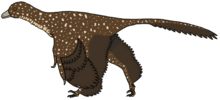 | |
| Epidexipteryx | hui | A scansoriopterygid dinosaur | 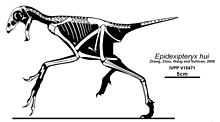 | |
| Epidendrosaurus | ningchengensis |  | ||
| Volaticotherium | V. antiquum | A gliding eutriconodont mammal | 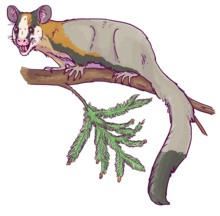 | |
| Castorocauda | C. lutrasimilis | 2006 | An aquatic docodont mammaliaform | 
|
| Microdocodon | M. gracilis | A docodont mammaliaform | ||
| Agilodocodon | A, scansorius | A docodont mammaliaform |  | |
| Megaconus | M. mammaliaformis | A possible allotherian mammal |  | |
| Mirusodens | M. caii | an arboreal/climbing euharamiyidan mammal/mammaliaform | ||
| Pseudotribos | P. robustus | A shuotheriid mammaliaform | 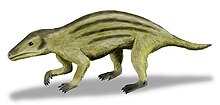 | |
| Liaosteus | L. hongi | 1995 | A peipiaosteid fish | |
| Yanliaomyzon | Y. ingensdentes | 2023 | A lamprey | 
|
Flora
| Fossil plants | |||||
|---|---|---|---|---|---|
| Genus | Species | State | Abundance | Notes | Images |
| Coniopteris | C. bella | Liaoning | A fern | ||
| C. burejensis | Liaoning | A fern | |||
| Sequoia | S. jeholensis | Ningcheng | The earliest known redwood tree | ||
| Schmeissneria | S. sinensis | Liaoning | Uncertain plant originally described as angiosperm. | ||
| Xingxueanthus | X. sinensis | Liaoning | Uncertain plant originally described as angiosperm. | ||
| Euanthus | E. panii | Liaoning | Uncertain plant originally described as angiosperm. | ||
See also
- Geology of Inner Mongolia
- Jurassic Asia and Jurassic System of Asia — period's Asian prehistoric life, geological formations, fossil record
- Yixian Formation
- Callovian formations
- Tiourarén Formation, fossiliferous formation of Niger
- Qiketai, Toutunhe, Shishugou and Qigu Formations, fossiliferous formations of the Junggar Basin, Xinjiang
- Oxfordian formations
- Oxford Clay, England
- Tendaguru Formation, fossiliferous formation of Tanzania
- Cañadón Calcáreo Formation, fossiliferous formation of the Cañadón Asfalto Basin, Argentina
References
- ^ Liu, Yongqing; Liu, Yanxue; Ji, S.; Yang, Z. (2006). "U-Pb zircon age for the Daohugou Biota at Ningcheng of Inner Mongolia and comments on related issues". Chinese Science Bulletin. 51 (21): 2634–2644. Bibcode:2006ChSBu..51.2634L. doi:10.1007/s11434-006-2165-2. S2CID 96442710.
- ^ Huang, D.; Cai, C.; Jiang, J.; Su, Y.; Liao, H. (2015). 道虎沟化石层及其底部砾岩段化石记录 [Dahugou bed and fossil record of its basal conglomerate section]. Acta Palaeontologica Sinica (in Chinese (China)). 54 (3): 75–81. ISSN 0001-6616.
- ^ Xu, Xing; Zhou, Zhonghe; Sullivan, Corwin; Wang, Yuan; Ren, Dong (2016). "An Updated Review of the Middle-Late Jurassic Yanliao Biota: Chronology, Taphonomy, Paleontology and Paleoecology". Acta Geologica Sinica - English Edition. 90 (6): 2229–2243. Bibcode:2016AcGlS..90.2229X. doi:10.1111/1755-6724.13033. ISSN 1755-6724. S2CID 133314433.
- ^ Ren, D.; et al. (2002). "On the biostratigraphy of the Jurassic fossil beds at Daohugou near Ningcheng, Inner Mongolia". Geol. Bull. China. 21: 584–591.
- ^ He, H.; Wang, X.; Zhou, Z.; Zhu, R.; Jin, F.; Wang, F.; Ding, X.; Boven, A. (2004). "(^40)Ar/(^39)Ar dating of ignimbrite from Inner Mongolia, northeastern China, indicates a post-Middle Jurassic age for the overlying Daohugou Beds". Geophysical Research Letters. 31 (20): L20609. Bibcode:2004GeoRL..3120609H. doi:10.1029/2004gl020792.
- ^ Gao, K.; Ren, D. (2006). "Radiometric dating of ignimbrite from Inner Mongolia provides no indication of a post-Middle Jurassic age for the Daohugou Beds". Acta Geologica Sinica - English Edition. 80 (1): 42–45. Bibcode:2006AcGlS..80...42G. doi:10.1111/j.1755-6724.2006.tb00793.x. S2CID 140588867.
- ^ Wang, Y; et al. (2006). "Biodiversity and palaeoclimate of the Middle Jurassic floras from the Tiaojishan Formation in western Liaoning, China". Progress in Natural Science. 16 (S1): 222–30. doi:10.1080/10020070612330087A (inactive 1 November 2024).
{{cite journal}}: CS1 maint: DOI inactive as of November 2024 (link) - ^ Jin, F.; Zhang, F.C.; Li, Z.H.; Zhang, J.Y.; Li, C.; Zhou, Z.H. (2008). "On the horizon of Protopteryx and the early vertebrate fossil assemblages of the Jehol Biota". Chinese Science Bulletin. 53 (18): 2820–2827. Bibcode:2008SciBu..53.2820J. doi:10.1007/s11434-008-0209-5. S2CID 133507763.
- ^ Yanxue, Liu; Yongqing, Liu; Hong, Zhang (2010-09-07). "LA-ICPMS Zircon U-Pb Dating in the Jurassic Daohugou Beds and Correlative Strata in Ningcheng of Inner Mongolia". Acta Geologica Sinica - English Edition. 80 (5): 733–742. doi:10.1111/j.1755-6724.2006.tb00296.x.
- ^ Gao, K. -Q.; Shubin, N. H. (2012). "Late Jurassic salamandroid from western Liaoning, China". Proceedings of the National Academy of Sciences. 109 (15): 5767–72. Bibcode:2012PNAS..109.5767G. doi:10.1073/pnas.1009828109. PMC 3326464. PMID 22411790.
- ^ Lian, Xin-Neng; Cai, Chen-Yang; Huang, Di-Ying (2021-04-29). "The early assemblage of Middle–Late Jurassic Yanliao biota: checklist, bibliography and statistical analysis of described taxa from the Daohugou beds and coeval deposits". Palaeoentomology. 4 (2): 095–136. doi:10.11646/palaeoentomology.4.2.1. ISSN 2624-2834.
- ^ Zhang, K.; Yang, D.; Ren, D.; Ge, F. (2008). "New Middle Jurassic tangle−veined flies from Inner Mongolia, China". Acta Palaeontologica Polonica. 53 (1): 161–164. doi:10.4202/app.2008.0112.
- ^ Xiong, Shurong; Engel, Michael; Xiao, Lifang; Ren, Dong (26 October 2021). "New archidermapteran earwigs (Dermaptera) from the Middle Jurassic of Inner Mongolia, China". ZooKeys (1065): 125–139. Bibcode:2021ZooK.1065..125X. doi:10.3897/zookeys.1065.72720. PMC 8563706. PMID 34759716.
- ^ Yin, Yuqing; Shih, Chungkun; Engel, Michael S.; Ren, Dong (2023-07-07). "New Earwigs from the Middle Jurassic Jiulongshan Formation of Northeastern China (Dermaptera)". Insects. 14 (7): 614. doi:10.3390/insects14070614. ISSN 2075-4450. PMC 10380475. PMID 37504620.
- ^ Gu J.-J., Montealegre-Z, F., Robert, D., Engel, M.S., Qiao G.-X., and Ren D. (2012). "Wing stridulation in a Jurassic katydid (Insecta, Orthoptera) produced low-pitched musical calls to attract females." Proceedings of the National Academy of Sciences, (advance online publication) doi:10.1073/pnas.1118372109
- ^ Li, Y-L.; Ren, D.; Shih, C-K (2008). "Two Middle Jurassic hanging-flies (Insecta: Mecoptera: Bittacidae) from Northeast China" (PDF). Zootaxa. 1929: 38–46. doi:10.11646/zootaxa.1929.1.2. ISSN 1175-5334.
- ^ Wang, Qi; Shih, Chungkun; Ren, Dong; Carrier, David (2013). "The Earliest Case of Extreme Sexual Display with Exaggerated Male Organs by Two Middle Jurassic Mecopterans". PLoS ONE. 8 (8): e71378. Bibcode:2013PLoSO...871378W. doi:10.1371/journal.pone.0071378. PMC 3743757. PMID 23977031.
- ^ Wang, Yongjie; Labandeira, Conrad C.; Shih, Chungkun; Ding, Qiaoling; Wang, Chen; Zhao, Yunyun; Ren, Dong (2012-12-11). "Jurassic mimicry between a hangingfly and a ginkgo from China". Proceedings of the National Academy of Sciences of the United States of America. 109 (50): 20514–20519. Bibcode:2012PNAS..10920514W. doi:10.1073/pnas.1205517109. ISSN 0027-8424. PMC 3528590. PMID 23184994.
- ^ Giribet, G., et al., 2012. An exquisitely preserved harvestman (Arthropoda, Arachnida, Opiliones) from the Middle Jurassic of China. Organisms, Diversity & Evolution, 12, p.51-56.
- ^ Selden, Paul A.; Shih, ChungKun; Ren, Dong (2011-10-23). "A golden orb-weaver spider (Araneae: Nephilidae: Nephila) from the Middle Jurassic of China". Biology Letters. 7 (5): 775–778. doi:10.1098/rsbl.2011.0228. ISSN 1744-9561. PMC 3169061. PMID 21508021.
- ^ Petrulevicius, J. F.; Huang, D-Y.; Ren, D. (2007). "A new hangingfly (Insecta: Mecoptera: Bittacidae) from the Middle Jurassic of Inner Mongolia, China" (PDF). African Invertebrates. 48 (1): 145–152. Archived from the original (PDF) on 2012-03-21. Retrieved 2011-08-29.
- ^ Liang, Junhui; Wang, Ying; Shih, Chungkun; Ren, Dong (2023-01-02). "A new Middle Jurassic cockroach (Blattaria: Blattulidae) from the Jiulongshan Formation of Daohugou in China". Biologia. 78 (6): 1429–1432. Bibcode:2023Biolg..78.1429L. doi:10.1007/s11756-022-01300-7. ISSN 1336-9563. S2CID 255378643.
- ^ Gao, Wei; Xu, Yifan; Shih, Chungkun; Ren, Dong; Wang, Yongjie (2023-06-18). "Two new genera of giant lacewings (Insecta, Neuroptera, Ithonidae) from the Middle Jurassic of China". Historical Biology. 36 (8): 1672–1676. doi:10.1080/08912963.2023.2224377. ISSN 0891-2963.
- ^ Huang, D.; Nel, A. (2008). "A new Middle Jurassic aphid family (Insecta: Hemiptera: Sternorrhyncha: Sinojuraphididae fam. nov.) from Inner Mongolia, China". Palaeontology. 51 (3): 715–719. Bibcode:2008Palgy..51..715H. doi:10.1111/j.1475-4983.2008.00773.x. S2CID 85818502.
- ^ Li, Yuling; Chang, Su-Chin; Zhang, Haichun; Wang, Jun; Pei, Rui; Zheng, Daran; Fang, Yan; Hemming, Sidney R. (November 2023). "A chronostratigraphic and biostratigraphic framework for the Yanliao Biota of northeastern China: Implications for Jurassic terrestrial ecosystems and evolution". Palaeogeography, Palaeoclimatology, Palaeoecology. 630: 111818. Bibcode:2023PPP...63011818L. doi:10.1016/j.palaeo.2023.111818.
- ^ Gao, Ke-Qin; Shubin, Neil H. (2003). "Earliest known crown-group salamanders" (PDF). Nature. 422 (6930): 424–428. Bibcode:2003Natur.422..424G. doi:10.1038/nature01491. PMID 12660782. S2CID 4411650.
- ^ Castorocauda - Science Magazine
- ^ Mao, Fangyuan; Li, Zhiheng; Hooker, Jerry J; Meng, Jin (2023-11-01). "A new euharamiyidan, Mirusodens caii (Mammalia: Euharamiyida), from the Jurassic Yanliao Biota and evolution of allotherian mammals". Zoological Journal of the Linnean Society. 199 (3): 832–859. doi:10.1093/zoolinnean/zlad050. ISSN 0024-4082.
- ^ Li, X.; Chen, Y. (2021). "The Mesozoic Acipenseriformes in northeast China and adjacent areas". IOP Conference Series: Earth and Environmental Science. 864 (1): 012005. doi:10.1088/1755-1315/864/1/012005. ISSN 1755-1315.
- ^ Wu, Feixiang; Janvier, Philippe; Zhang, Chi (2023-10-31). "The rise of predation in Jurassic lampreys". Nature Communications. 14 (1): 6652. Bibcode:2023NatCo..14.6652W. doi:10.1038/s41467-023-42251-0. ISSN 2041-1723. PMC 10618186. PMID 37907522.
- ^ Li, Fang-Yu; Xiu, Yun-Yan; Tan, Xiao; Tian, Ning (2023-06-26). "The new records of Coniopteris (Dicksoniaceae, Filicales) with in-situ spores from the Middle Jurassic of northeastern China and its spatio-temporal distribution in China". Review of Palaeobotany and Palynology. 316: 104937. Bibcode:2023RPaPa.31604937L. doi:10.1016/j.revpalbo.2023.104937.
- ^ Qing-Wen Ma; David K. Ferguson; Hai-Ming Liu; Jing-Xian Xu (2021). "Compressions of Sequoia (Cupressaceae sensu lato) from the Middle Jurassic of Daohugou, Ningcheng, Inner Mongolia, China". Palaeobiodiversity and Palaeoenvironments. 101 (1): 25–33. Bibcode:2021PdPe..101...25M. doi:10.1007/s12549-020-00454-z. S2CID 227180592.
- ^ Xin Wing; Shuying Duan; Baoyin Geng; Jinzhong Cui; Yong Yang (2007). "Schmeissneria: A missing link to angiosperms?". BMC Evolutionary Biology. 7: 14. doi:10.1186/1471-2148-7-14. PMC 1805421. PMID 17284326.
- ^ Sokoloff, Dmitry D.; Remizowa, Margarita V.; El, Elena S.; Rudall, Paula J.; Bateman, Richard M. (2020). "Supposed Jurassic angiosperms lack pentamery, an important angiosperm-specific feature". The New Phytologist. 228 (2): 420–426. doi:10.1111/nph.15974. ISSN 0028-646X. JSTOR 26968097. PMID 31418869.
- ^ Xin WANG; and Shijun WANG (2010). "Xingxueanthus: An Enigmatic Jurassic Seed Plant and Its Implications for the Origin of Angiospermy". Acta Geologica Sinica - English Edition. 84 (1): 47–55. Bibcode:2010AcGlS..84...47W. doi:10.1111/j.1755-6724.2010.00169.x. S2CID 140739086.
{{cite journal}}: CS1 maint: multiple names: authors list (link) - ^ Coiro, Mario; Doyle, James A.; Hilton, Jason (2019). "How deep is the conflict between molecular and fossil evidence on the age of angiosperms?". New Phytologist. 223 (1): 83–99. doi:10.1111/nph.15708. ISSN 0028-646X. PMID 30681148.
- ^ "PBDB Collection". paleobiodb.org. Retrieved 2024-05-10.
Further reading
- Liaoning Stratigraphic Group. 1978. The Stratigraphic Tables of Liaoning. Geology Press 1-296